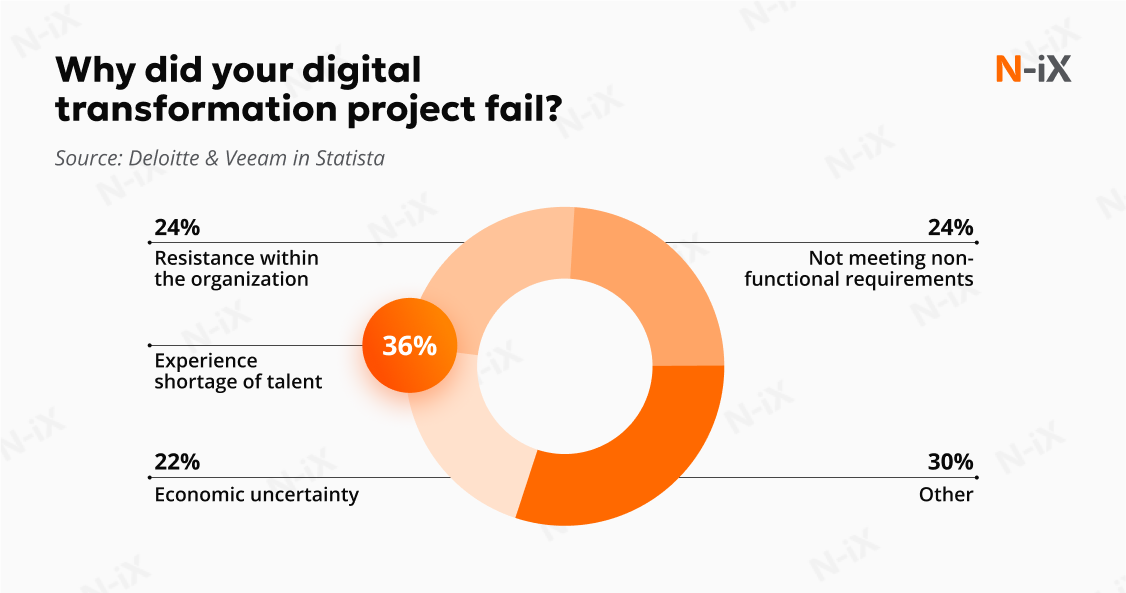90% of enterprises recognize the need for rapid change and have launched digital transformation initiatives as of 2023 [1]. Digital transformation goes beyond merely upgrading systems; it reshapes processes, culture, and even business models. It is, however, a critical investment that does not pay off for most organizations. Moreover, Deloitte finds that 70% of these projects fall short of their objectives. But why?
Let’s take a look at the main digital transformation challenges and how digital transformation outsourcing paired with tech consulting can help address them.
Why do digital transformation projects fail?
We will analyze the biggest vulnerability points in outsourcing digital transformation and understand how to avoid them. Deloitte names three major reasons why digital transformation projects fail: resistance within the organization, not meeting non-functional requirements, and economic uncertainty. Deloitte also highlights talent shortage as one of the common challenges. Now, we will break down each of these challenges:

The first reason, resistance within the organization, often boils down to a simple truth: people fear what they don’t understand. A single narrative clearly spelling out the why and how, and incorporating feedback from the employees, is a powerful force.
The second reason for not meeting non-functional requirements relates to the evolving nature of ESG, security, and regulatory compliance. Agile digital transformation outsourcing services bring modular, cloud-native architectures, enabling real-time adaptation during development and easy post-launch updates to keep pace with evolving ESG, security, and compliance requirements.
Another major concern commonly reported is the difficulty in attracting expertise. Partnering with an experienced outsourcing provider helps to gain access to world-class expertise along with the flexibility the project needs.
Lastly, the same development flexibility can be applied to concerns of economic instability interrupting the transformation process. Modular, cloud-native architectures allow for adjusting scope and resource allocation during economic instability, safeguarding budgets and timelines by enabling scaling down or up as needed, thus keeping digital transformation on track.
Safeguarding against these common vulnerabilities significantly increases the odds that your digital transformation project will achieve its goals and bring a significant payoff.
6 steps to pass the most common digital transformation roadblocks
Based on the top four reasons digital transformation projects stumble, N-iX experts have developed a straightforward six-step checklist to help simplify this complex process.

1. Establish clear internal communication
While most executives agree that digital transformation is a necessary and will directly influence the evaluation of their enterprise, within organizations, the perspectives on what such an initiative must entail often diverge. 24% of C-suite executives name poor internal communication as the main reason the transformation project couldn’t succeed [2].
Issues with internal communication during digital transformation outsourcing usually stem from the very complexity that makes these initiatives so valuable. The projects often span multiple departments, with each team having its own needs, tools they are used to, and jargon. Moving everyone to a common digital platform without first aligning on what success looks like, messages get lost in translation, and priorities compete rather than converge.
Read more: Achieving digital transformation in banking one step at a time
Gathering feedback from all relevant teams is crucial not only for adopting changes but also for understanding each department's unique workflows, data requirements, and integration needs. This valuable insight allows for the customization of features and interfaces, ensuring that the final solution effectively addresses specific challenges rather than investing in the abstract "digital transformation" concept. Minor miscommunication can often lead to costly redevelopments and integrations down the line.
To establish clear communication, create a shared glossary, start meetings with a "what doessuccess look like" check, redefine roles, implement regular feedback loops through surveys or stand-ups, and invest in communication skills training. This ensures clarity, aligns priorities, and allows for early identification of misunderstandings in digital transformation projects.
2. Form a comprehensive strategy
Only 34% of enterprises formulate a digital transformation strategy before commencing their projects. A clear, step-by-step roadmap is essential for navigating the inherent complexities of significant organizational change. Developing a robust strategy naturally forces the organization to deconstruct ambitious objectives into achievable steps, establish realistic timelines, proactively identify potential risks, and clearly assign responsibilities.

Many successful projects engage technology consulting during this phase. External experts bring proven methodologies and an unbiased external viewpoint. Internal teams often specialize in the upkeep of current systems, while consultants offer insights into industry trends and modern technologies.
Internal teams, together with technology consultants, thoroughly assess the current environment, meticulously map system dependencies, strategically select the most suitable tools, and thoughtfully sequence implementation phases. Ultimately, the goal is to create a detailed playbook encompassing key milestones, relevant KPIs, and comprehensive communication plans, thereby mitigating the risk of future costs.
Read more: Revamp your business: A look at the power of digital transformation consulting
3. Account for non-functional requirements
Another significant reason why digital transformation projects fail, cited by 24% of unsuccessful initiatives, is the neglect of ESG, security, and regulatory compliance requirements during the initial planning stages. While addressing these aspects might seem less urgent under tight deadlines, as they don't yield immediate visible results, their omission can render the entire digital transformation effort futile. The principles of ESG, data security, and regulatory compliance are intrinsically linked with digital transformation. They significantly impact the risk profile, trust of the stakeholders, and ultimately, the viability of deploying the new digital platform. Integrating sustainability and governance objectives from the outset can transform ESG considerations from a mere obligation into a distinct competitive advantage.
Read more: ESG and digital transformation: technologies and strategies
Digital transformation outsourcing projects often span lengthy timelines and must adapt as requirements evolve. Integrating specific ESG goals into project KPIs ensures sustainability is a core component of the digital transformation and prepares it for future objectives. Systems should be designed with flexibility and built on clear policies with adaptable settings. Regular automated checks for compliance and potential security issues should be integrated into the development process to identify risks early on. Systems that manage data based on its characteristics should be used to ensure ESG standards and data governance are followed. Responsibilities for meeting regulatory requirements should be clearly assigned, and a system for ongoing monitoring and policy updates should support this.
Managing these requirements calls for a cross-functional compliance team from day one, bringing together legal, IT, security, and operations. This team translates regulatory mandates into actionable process checklists, data-classification frameworks, and audit-ready logs starting in the proof-of-concept phase.

4. Choose end-to-end custom solution development
Choosing an end-to-end custom solution development approach ensures that every component, from user workflows to backend integrations, is designed around the unique needs and goals of a digital transformation initiative. While out-of-the-box solutions might be suitable for smaller businesses, they almost never meet the needs of more complex operations. Custom development helps avoid several critical failure points:
- Misaligned functionality: Prebuilt modules rarely match the functionality that is required by a specific organization, leading to unexpected costs of developing and integrating the missing functionality.
- Integration: End-to-end development guarantees seamless APIs and data flows, preventing information silos and manual reconciliations. Meaning they are significantly more flexible in their integration capacities.
- Security blind spots: Integration issues between disparate systems create dangerous cybersecurity gaps. Custom solutions with built-in security and specific controls prevent breaches and audits by addressing these gaps. Additionally, there may be hidden dependencies in the systems that would not meet security and regulatory requirements.
- Scalability constraints: Off-the-shelf platforms often hit performance limits as user loads grow or processes diversify. A bespoke architecture anticipates future growth, with modular components that can be upgraded or replaced independently.
- Vendor lock-in and upgrade pain: Relying on licensed software ties organizations to release schedules, pricing changes, and deprecation cycles. Custom code grants full ownership over feature roadmaps, updates, and long-term support.
Read more: Digital transformation in manufacturing: technologies reshaping the industry
5. Attract top talent
A third of executives report having insufficient talent for implementing technological changes in their companies [5]. Recruiting, onboarding, and retaining those specialists can stretch HR bandwidth and budgets, especially when projects demand rapid turnaround and a mix of complementary proficiencies. Digital transformation outsourcing is a perfect answer to this concern.

Tapping into specialized providers instantly opens access to a vetted pool of experts without recruiting churn, shaving weeks or even months off project timelines. For example, with over 2,400 professionals on board, N-iX can fill a position in 3-4 weeks, due to our large recruitment database. Outsourcing provides built-in scalability: teams can be ramped up or down as priorities shift, while converting fixed headcount costs into flexible, outcome-driven investments.
Our digital transformation services range from in-depth assessment of business transformation readiness to business & tech consulting and full-cycle implementation. This means we can support your digital transformation journey at every step, from creating custom-fit strategies to implementing them and optimizing business and tech operations.
Read more about N-iX expertise: Digital transformation case studies: Top 3 success stories in 2025
6. Continuously monitor technological investment value
34% of a sample of industry leaders recognize AI as the current generation of digital transformation; at the same time, 65% of companies do not track KPIs for their AI projects. Without baseline KPIs tied to financial or operational outcomes, there’s no objective way to compare initiatives or justify further investment. There is a real risk of allocating resources to underperforming projects or holding onto software that should be sunsetted.
Reap the benefits of AI for enterprises with a tailored strategy—access our expert insights today!


Success!

In a well-designed technology investment value monitoring system, KPI data flows into live dashboards so trends become visible in real time. Automated alerts and governance checkpoints activate whenever performance drifts beyond set thresholds, prompting swift reviews or budget adjustments.
The outcome is a feedback-driven digital transformation outsourcing: underperforming initiatives are scaled back early, impactful initiative results receive further funding, and resources gravitate toward the highest-value bets.
Conclusion
In essence, successful digital transformation outsourcing hinges on strategic planning, clear communication and engagement, and adaptability. Prioritizing these elements can help you avoid common pitfalls, maximize your return on investment, and effectively utilize external expertise to navigate the complexities of digitalization. A successful digital transformation strategy transcends technology implementation; it aims to future-proof the organization through a culture of ongoing improvement and adaptation to evolving business requirements.
References
- What is digital transformation? McKinsey, 2024
- Do You Really Know The Financial Impacts of Your Digital Transformation? Delloitte, 2023
- Ibid.
- KPMG global tech report 2023
Have a question?
Speak to an expert




